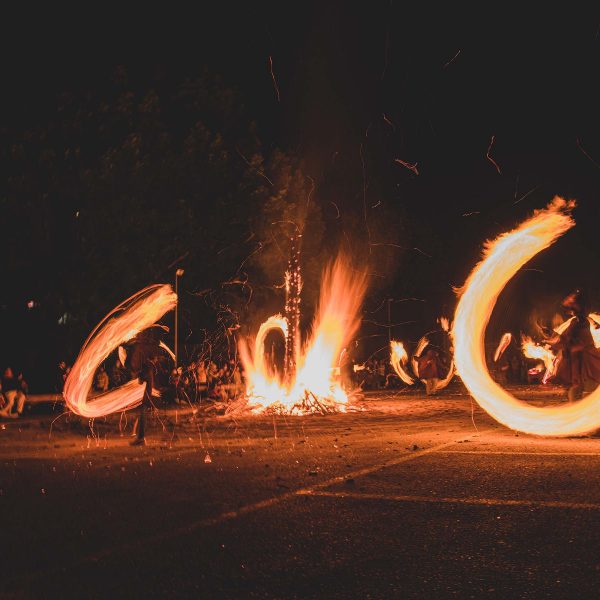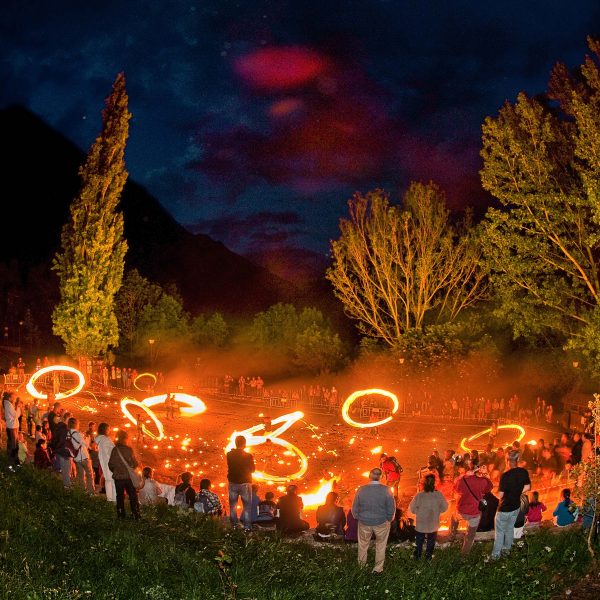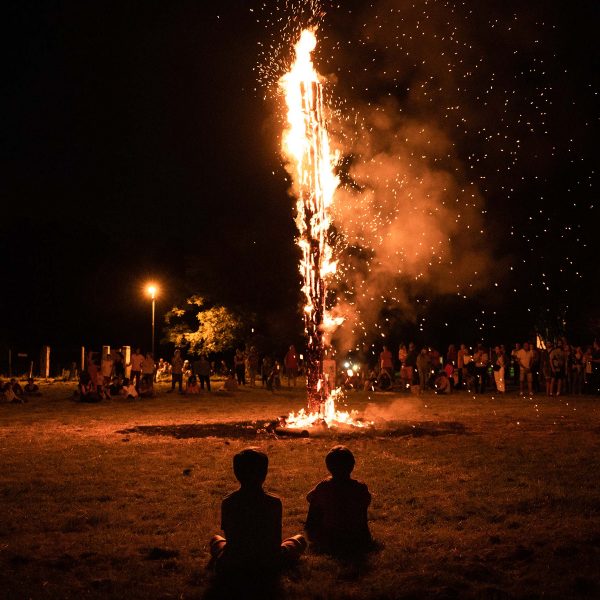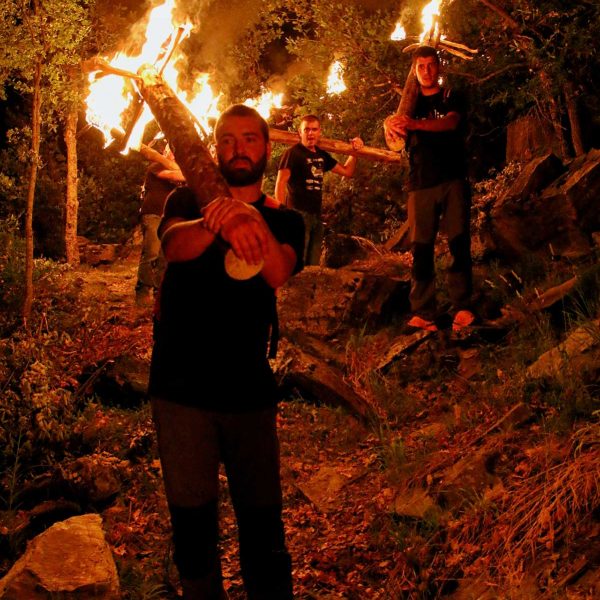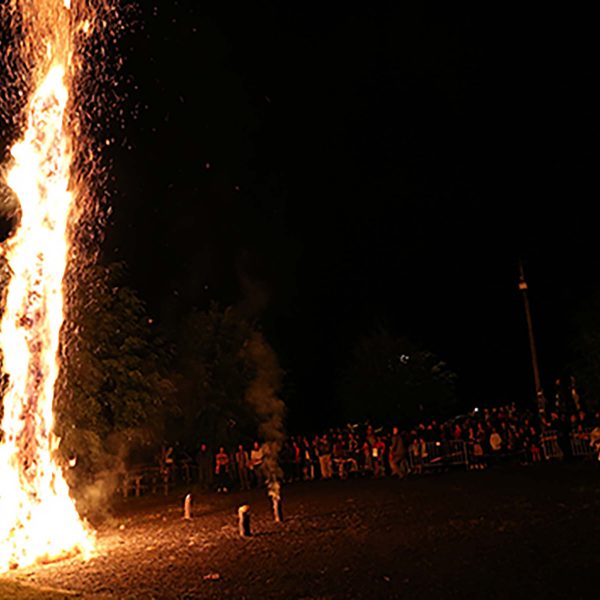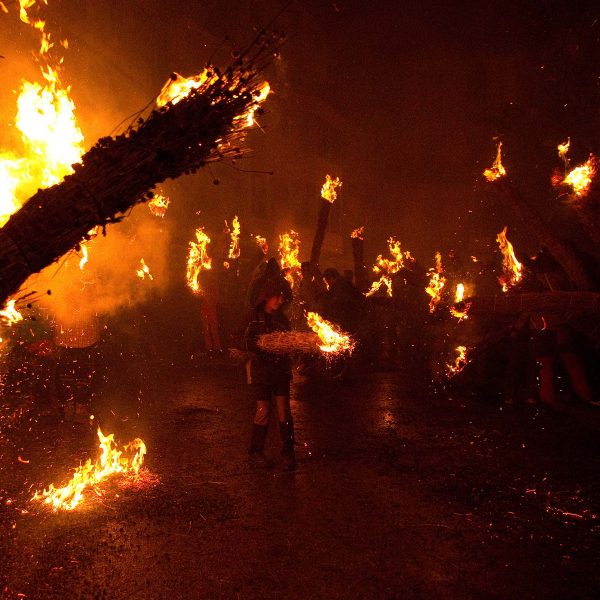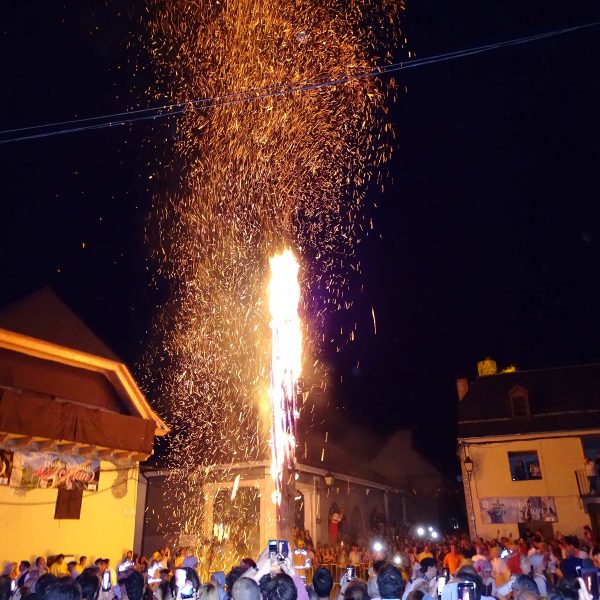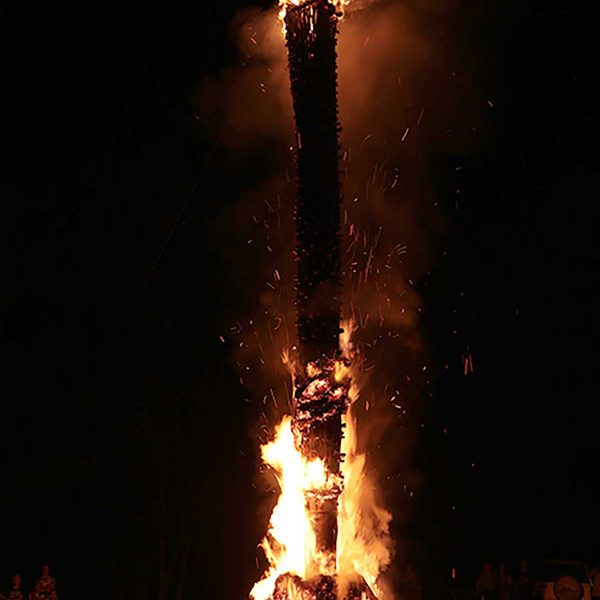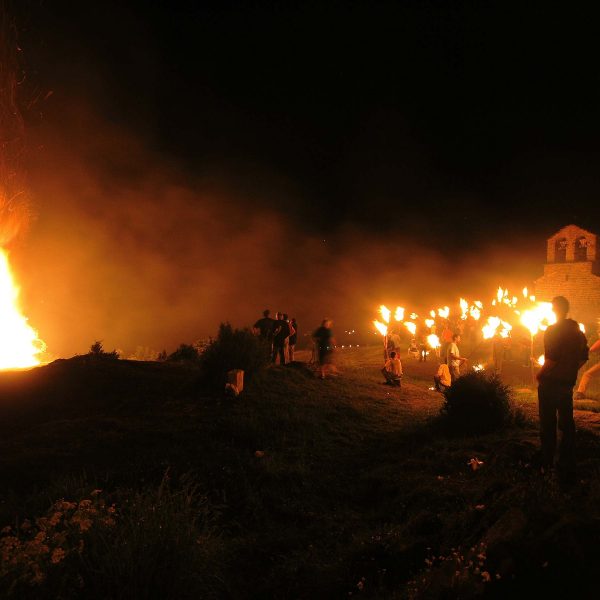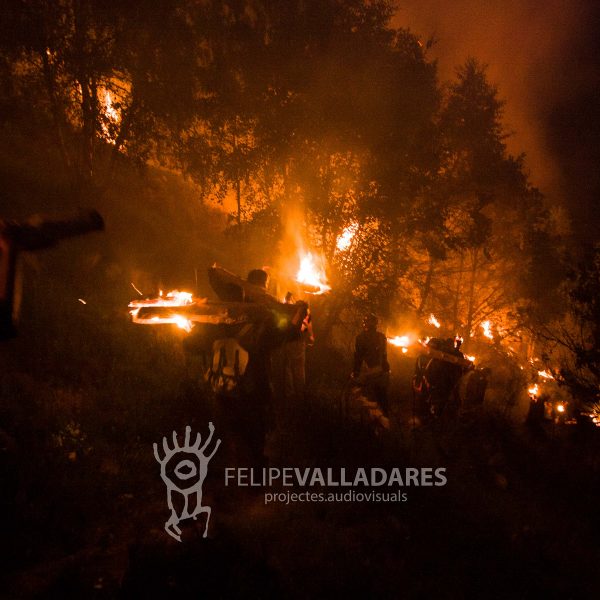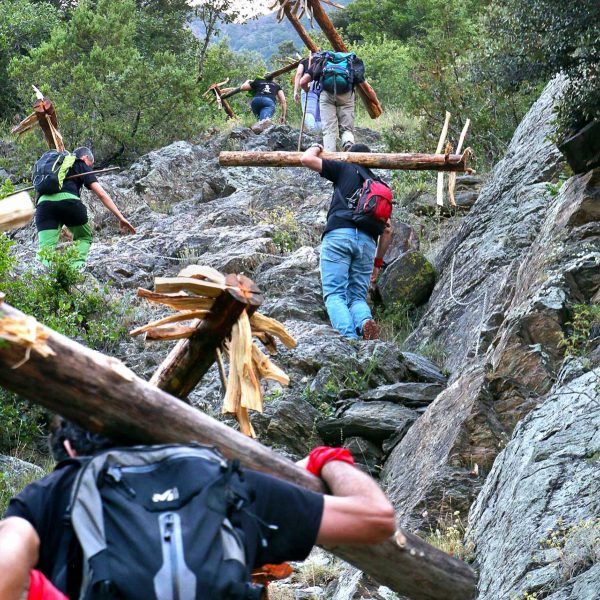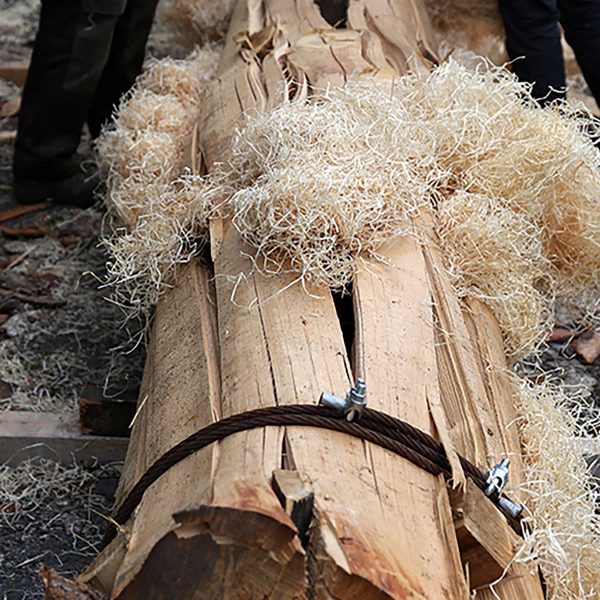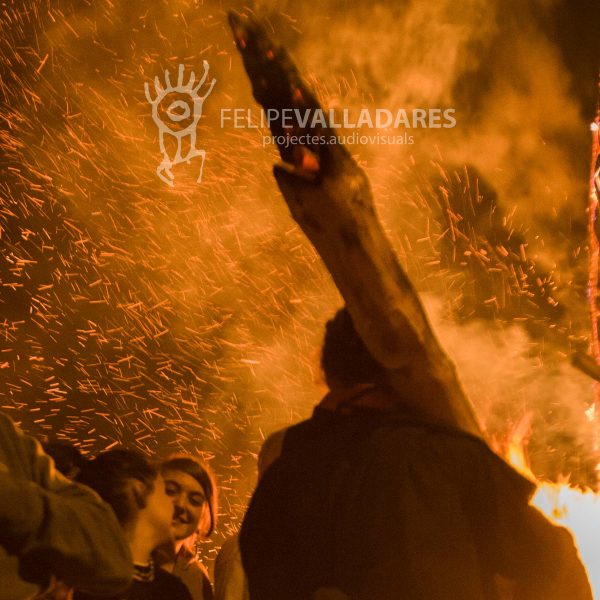The fire festivals are celebrated in some one hundred and thirty towns in the Pyrenees, although only sixty-three have so far been recognized by UNESCO.
These festivities are community celebrations that have been sustained over many generations and are now considered to be “world heritage.” They are also examples of cross-border heritage, spanning three countries (Spain, France, and Andorra) and three regions (Aragon, Catalonia, and Occitania). As such, they also symbolize a common Pyrenean identity.
For the people who celebrate them, the festivities are an event of special importance, an occasion to regenerate social ties and strengthen feelings of community belonging, identity, and continuity.
Although all these festivities have some elements in common, they are celebrated in different ways. They also have a variety of different names and are not always celebrated on the same date.
Different kinds of festival
There are basically three kinds of festival:
1) Falles (torches) are lit from a faro (a beacon) and are carried down to the village by a group of fallaires (torch-bearers), creating a line of fire that snakes down the mountain. In the village, the remaining villagers light more falles, a larger falla, or a second beacon. This is the most frequent model in Catalonia and Aragon.
2) Haros and brandons: in this format, a tree trunk is prepared a few months or even a year in advance and is set alight on the night of the festival. This is the predominant model in Occitania in France and the Aran Valley in Spain. The festivities are held in a field or in the village square. This gigantic torch is generally known as a brandon in French, but other Occitan terms are also used, such as halhar in the Luchon area, har in other parts of the Comminges and Couserans, and haro and taro in the Aran Valley.
3) The falles are lit in the town or village before being carried round the streets, as in Andorra. In some towns, such as Andorra la Vella, people swing the torches in circles, creating balls of fire. This is also done in some villages belonging to the first two models, such as Les or Saúnc.
Different names
The festivals are celebrated in places in which different languages are spoken (Catalan, Occitan, Spanish, French, and Aragonese). For this reason, they have a variety of different formats and names.
- La Cremada de Falles (Andorra)
- Les Falles (Isil, Saünc, Bonansa)
- Baixada de Falles (Vilaller, Montanui, Aneto, Castanesa, Senet, Alins)
- Córrer les Falles (Erill la Vall, Boí, Barruera, Durro, Taüll, El Pont de Suert, Casós, Llesp)
- Corré las Fallas (Les Paüls)
- Festa de la Falleta (San Chuán de Plan)
- Las Fallas (Bonansa)
- Le Brandon de la Saint-Jean (et de la Saint-Pierre) (Bagnères-de-Luchon)
- Crema deth Taro (Arties)
- Crema deth Haro e des Halhes (Les)
- Quilhadeth Haro (Les)
- La Biga (Senet)
- La Fia-faia (Bagà i Sant Julià de Cerdanyola)
- Falles de la Verge de la Ribera (La Pobla de Segur)
- Brandon, Eth Halhar, Eth Haro, Eth Hart, Era Halha (Occitania)
Dates
Most of the festivals are held on Saint John’s Eve, although some are held at the same time as the annual village festival or at other times.
June
Closest Saturday to Saint Quirc’s Day (June 16)
- Durro (Alta Ribagorça)
Mare de Déu de la Ribera (June 17)
- La Pobla de Segur (Pallars Jussà)
Samedi du week-end antérieur à la Saint Jean (24 juin)
- Senet (Haute Ribagorce)
Saturday before Saint John’s Day (before June 24)
- Senet (Alta Ribagorça)
Saint John’s Eve (June 23)
- Alins (Pallars Sobirà)
- Andorra la Vella (Principat d’Andorra)
- Arties (Val d’Aran)
- Boí (Alta Ribagorça)
- Bonansa (Ribagorza)
- Casós (Alta Ribagorça)
- El Pont de Suert (Alta Rinagorça)
- Encamp (Principat d’Andorra)
- Escaldes-Engordany (Principat d’Andorra)
- Gotarta (Alta Ribagorça)
- Isil (Pallars Sobirà)
- La Guingeta d’Àneu (Pallars Sobirà)
- Laspaúls (Ribagorça)
- Les (Val d’Aran)
- Montanuy (Ribagorça)
- Sahún (Valle de Benasque)
- San Chuán de Plan / San Juan de Plan (Sobrarbe)
- Sant Julià de Lòria (Principat d’Andorra)
- Suils (Ribagorza)
- Vilaller (Alta Ribagorça)
- Villarrué (Ribagorza)
On or around June 24
- Anla (Barousse, 65)
- Antichan (Barousse, 65)
- Aveux (Barousse, 65)
- Bagnères-de-Luchon (Commenges, 31)
- Bertren (Barousse, 65)
- Bramevaque (Barousse, 65)
- Casarilh (Barousse, 65)
- Créchets (Barousse, 65)
- Esbareich (Barousse, 65)
- Ferrère (Barousse, 65)
- Gembrie (Barousse, 65)
- Ilheu (Barousse, 65)
- Izaourt (Barousse, 65)
- Juzet-de-Luchon (Commenges, 31)
- Loures-Barousse (Barousse, 65)
- Mauléon-Barousse (Barousse, 65)
- Montauban-de-Luchon (Commenges, 31)
- Moustajon (Commenges, 31)
- Oô (Commenges, 31)
- Ourde (Barousse, 31)
- Sacoué (Barousse, 65)
- Saint-Aventin (Commenges, 31)
- Saint-Mamet (Commenges, 31)
- Sainte-Marie (Barousse, 65)
- Saléchan (Barousse, 65)
- Salles-et-Pratviel (Commenges, 31)
- Samuran Samuran (Barousse, 65)
- Sarp (Barousse, 65)
- Siradan (Barousse, 65)
- Sost (Barousse, 65)
- Troubat (Barousse, 65)
- Vallée d’Oueil (Commenges, 31)
First weekend after Saint John’s Day (June 24)
- Barruera (Alta Ribagorça)
Last Saturday in June:
- València d’Àneu (Pallars Sobirà)
Saint Peter’s Day (June 28)
- Castanesa (Ribagorza)
- Ordino (Principat d’Andorra)
July
First Saturday in July
- Alós d’Isil (Pallars Sobirà)
- Aneto (Ribagorza)
Saturday nearest to Saint Christopher’s Day (July 10)
- Erill La Vall (Alta Ribagorça)
Third Friday in July
- Taüll (Alta Ribagorça)
Fourth Saturday in July
- LLesp (Alta Ribagorça)
Christmas Eve (December 24)
- Bagà (Berguedà)
- Sant Julià de Cerdanyola (Berguedà)
Elements in common
Despite this diversity, the festivities have much in common: a large fire that can be seen by everyone (the faro where the falles are lit, the brandons, and the falles majors) and, of course, falles of many different shapes and sizes, which are carried by both children and adults. All the festivals involve fire, smoke, embers, music, water, and a community celebration in the village square. There are also a series of practices linked to the purifying nature of fire. The element was believed to protect the households and to bring good fortune, so pieces of charred wood were kept in the houses (and still are!). The night, as is the case in many other summer fire festivals around the world, is seen as magical. It symbolizes the passing of generations and is associated with love, with newlyweds playing a prominent role and couples becoming engaged.
 Occitan
Occitan



